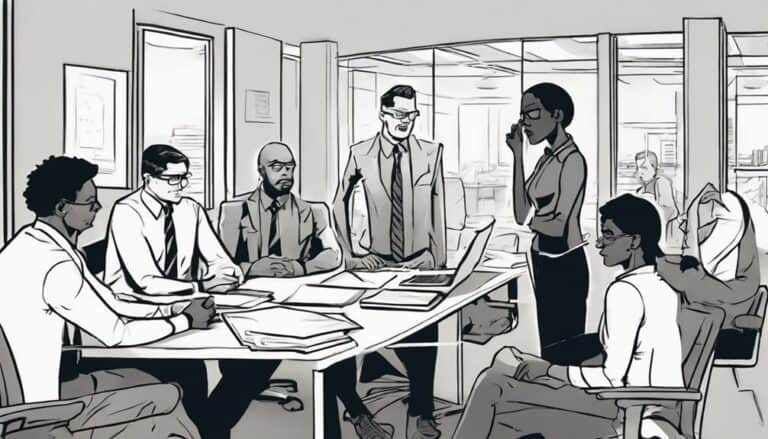When you step into the workplace, every interaction becomes a dance of unspoken cues that can shape the course of your professional relationships. From a subtle nod to a firm handshake, nonverbal communication holds the power to convey more than words alone.
Understanding how these signals influence perceptions and outcomes is key to maneuvering the intricacies of workplace dynamics.
So, how exactly can your nonverbal cues impact the way others perceive and engage with you in a professional setting?
Key Takeaways
- Nonverbal cues like eye contact and gestures enhance communication and build trust.
- Misinterpreting body language can lead to misunderstandings and conflicts in the workplace.
- Positive nonverbal signals convey empathy, respect, and credibility among colleagues.
- Increased nonverbal awareness shapes perceptions, fosters collaboration, and enhances productivity.
Importance of Nonverbal Communication in Workplace
In the workplace, understanding the importance of nonverbal communication is important for fostering effective interactions and relationships among colleagues. Nonverbal communication plays a crucial role in conveying messages beyond words. Your nonverbal communication skills, such as posture, gestures, facial expressions, and good eye contact, can greatly impact how you're perceived by others. Utilizing positive nonverbal cues can enhance your ability to communicate with others, build trust, and establish rapport in the workplace.
The significance of nonverbal communication lies in its ability to reinforce verbal messages, express emotions, and establish credibility. By being aware of the types of nonverbal cues you're sending, you can align your words with your body language to convey sincerity and authenticity. Good eye contact, for example, demonstrates attentiveness and active listening, which are essential for effective communication. Mastering effective nonverbal communication can help you navigate diverse work environments, bridge cultural differences, and strengthen relationships with your colleagues.
Enhancing Workplace Interactions Through Nonverbal Cues
Enhance your workplace interactions by leveraging nonverbal cues such as eye contact and gestures to demonstrate active listening and engagement. Positive non-verbal cues, like maintaining open body language and offering a warm smile, can help in creating a welcoming atmosphere for effective workplace communication. Your nonverbal messages play a vital role in building trust, credibility, and fostering strong relationships with your colleagues and clients. When utilized effectively, nonverbal cues can enhance team collaboration and contribute to overall job satisfaction.
In leadership communication, nonverbal cues are essential for conveying confidence, empathy, and support to team members, thereby boosting morale and productivity. By being mindful of your body language and utilizing positive nonverbal cues, you can establish a foundation of trust and understanding in your workplace interactions. Remember, your nonverbal communication speaks volumes and can greatly impact how your messages are received and interpreted by others.
Nonverbal Communication Pitfalls to Avoid
Are you aware of the potential pitfalls associated with misinterpreting nonverbal cues in the workplace? Understanding nonverbal communication pitfalls is important for effective workplace interactions. Misreading body language or failing to notice positive non-verbal cues can lead to misunderstandings and conflicts among colleagues. Inconsistencies in non-verbal behavior, such as avoiding eye contact or sending mixed signals, can create confusion and impact trust within teams. It's essential to remember that communication without words plays a major role in workplace communication.
To help you navigate these challenges, consider the following nonverbal communication pitfalls to avoid:
| Nonverbal Communication Pitfalls | Impact on Workplace Communication |
|---|---|
| Misinterpreting body language | Misunderstandings and conflicts |
| Ignoring cultural differences | Communication breakdowns |
| Lack of awareness of nonverbal cues | Hindered collaboration and teamwork |
| Over-reliance on nonverbal cues | Confusion and trust issues |
Being mindful of these pitfalls and enhancing your verbal communication skills can greatly improve interactions in the workplace while fostering a positive work environment.
Leveraging Nonverbal Signals for Effective Communication
Utilizing nonverbal cues effectively can greatly enhance communication dynamics in the workplace, fostering better understanding and collaboration among colleagues. When leveraging nonverbal signals for effective communication, consider the following:
- Body Language: Pay attention to your body language as it can convey confidence, openness, and receptiveness.
- Facial Expressions: Expressions like smiling or nodding can signal attentiveness and agreement, improving the overall interaction.
- Maintaining Eye Contact: Sustaining eye contact demonstrates attentiveness and interest in the conversation, building rapport.
- Open Body Language: Having open and relaxed body posture can encourage openness and trust among team members.
Improving Workplace Dynamics With Nonverbal Awareness
Improving workplace dynamics through heightened awareness of nonverbal cues fosters better understanding and collaboration among colleagues. By paying attention to nonverbal cues such as body language, eye contact, and gestures, you can create a positive work environment that enhances team morale and builds rapport. Utilizing positive nonverbal cues not only conveys empathy and respect but also boosts credibility, leading to improved relationships with your coworkers. This increased nonverbal awareness plays a critical role in shaping perceptions and fostering a harmonious atmosphere within the workplace, ultimately enhancing productivity.
| Nonverbal Cues | Impact on Workplace Dynamics |
|---|---|
| Open Body Language | Enhances understanding and collaboration among colleagues |
| Eye Contact | Builds rapport and conveys respect |
| Friendly Gestures | Boosts team morale and creates a positive work environment |
Conclusion
To sum up, mastering nonverbal communication in the workplace can greatly impact your interactions and relationships with colleagues.
While some may argue that focusing on nonverbal cues takes too much effort, the benefits of improved communication, stronger connections, and a more positive work environment far outweigh any initial challenges.
By being mindful of your body language, gestures, and tone of voice, you can enhance your workplace interactions and ultimately contribute to a more successful and harmonious team dynamic.

